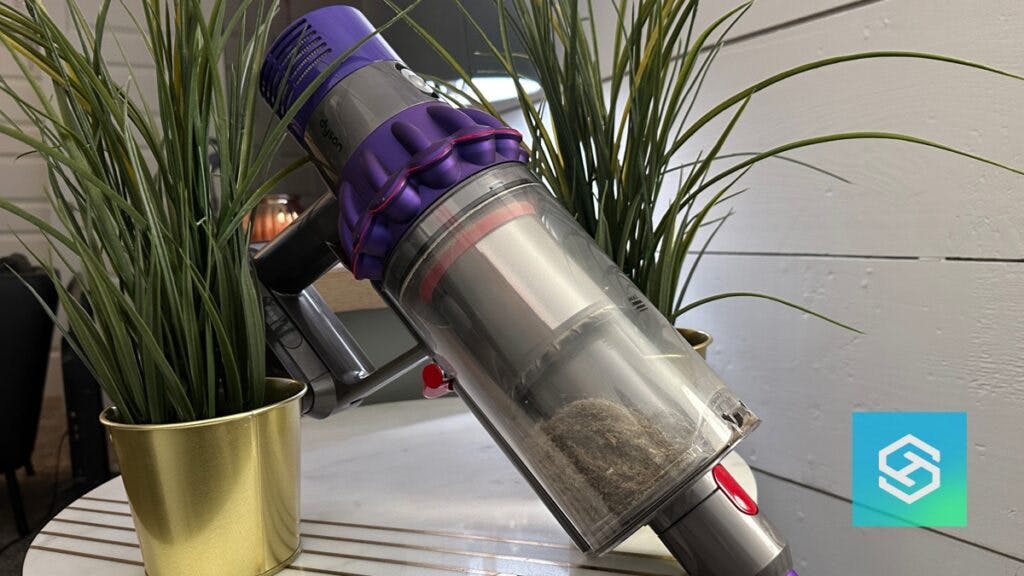How to Empty a Dyson Vacuum? (With Video)
By Trae Jacobs,
When you buy through our links, we may earn an affiliate commission.
Dyson vacuums need to be emptied regularly, just like any other vacuum. Dyson appliances are very expensive; it’s something everyone hopes to have for a long time. Here’s how to easily empty your vacuum.
How to Empty a Cordless Dyson Vacuum
To ensure your Dyson vacuum works properly, you must conduct regular maintenance. Otherwise, dirt and debris can build up in the canister and reduce suction power.
Compared to the V8, newer models have higher suction power, longer run time, and capacious dustbins. However, you can empty all cordless Dyson with a few simple steps:
- Unplug the Vacuum and detach the wand for safe and accessible emptying.
- Position the vacuum over a trash bin and empty the dustbin canister.
- Release the trap door by pressing the red button or lever.
- Raise the cyclone filter to prevent dirt from trapping in the bin.
- Detach the canister and clean it with a damp cloth (applicable on Dyson V10, V11, and V15)
- Return the cyclone filter back to its regular position.
- Securely shut the trap door by manually clicking it into place.
How to Empty Corded Dyson Vacuums
Dyson also offers various models of corded vacuums, such as the Animal 2 and Ball Animal. The Animal 2 delivers better cleaning performance compared to the Ball Animal.
However, it is heavier in weight and creates more noise during operation. But you can empty the canister of both Dyson Ball models through a similar process:
- Turn off the vacuum power before emptying the canister for safety purposes.
- Detach the canister and cyclone by pressing the bin release button located on top of the vacuum.
- Lift the canister and cyclone away from the vacuum unit.
- Hold the vacuum deep inside a suitable bin, ideally outdoors, for efficient emptying.
- Open the trap door and gently release the dirt.
- Close the trap door by pushing it until you hear it click into place.
- Reattach the bin to the vacuum.
Tips and Tricks for Emptying Dyson Vacuums

Use these tips to efficiently empty and clean your Dyson vacuum’s canister:
- Choose a well-ventilated area for emptying to reduce unpleasant odors and dust inhalation.
- Empty the canister in a wide bin to ensure nothing falls out during the emptying process.
- Use a damp microfiber cloth to wipe the dustbin and remove excess debris.
- Be patient with stiff emptying buttons; they’ll loosen with time and usage.
- Clean Dyson vacuum accessories to enhance the machine’s performance.
- Avoid emptying in hot areas to protect battery life.
What Can Happen if You Don’t Empty a Dyson Vacuum Cleaner?
Even though Dyson vacuums last around 7 to 10 years with proper maintenance, not emptying the device regularly affects its performance and longevity.
These are some reasons it is important to empty your Dyson vacuum cleaner regularly:
- Debris lodged within the vacuum’s inner system can cause malfunctions over time, leading to costly repairs.
- Overfilling the dust cup can diminish suction power performance, making it less effective in cleaning your home.
- Letting dirt and debris sit in the dust cup for extended periods can result in mold growth and emit unpleasant odors.
- Germs and bacteria can proliferate inside the vacuum if debris isn’t promptly emptied and impact indoor air quality.
- An overfilled dust cup can cause the vacuum’s motor to overheat, leading to automatic shutdown.
FAQ: Emptying Dyson Vacuums
Will a Dyson vacuum say when it is full?
Dyson vacuums do not have a built-in indicator to signal when they are full. Users should monitor the dust canister’s fill-up line to check whether it needs emptying.
How often should you empty a Dyson vacuum canister?
The frequency of emptying a Dyson vacuum canister varies but is generally recommended after each use to maintain optimal performance.
Do Dyson vacuums have bags?
Dyson vacuums do not use bags; they employ a bagless design with dust canisters for dirt and debris collection.
Related Articles

